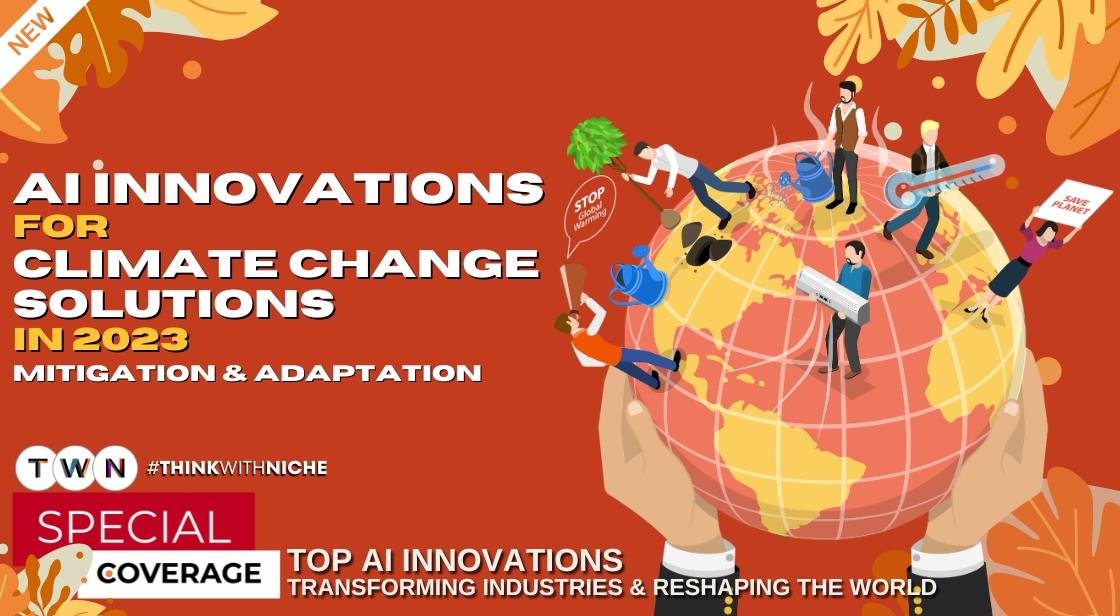AI Innovations for Climate Change Solutions in 2023: Mitigation & Adaptation

Blog Post
Amidst the global discourse at the COP28 Climate Summit 2023, a beacon of hope emerged in the convergence of Artificial Intelligence (AI) and climate action. This pivotal moment witnessed the unveiling of innovative AI-driven solutions, marking a transformative stride in the quest to combat climate change.
In the backdrop of this momentous event, the symbiotic relationship between AI and environmental stewardship took center stage, showcasing unprecedented advancements in both mitigation and adaptation strategies.
This comprehensive exploration delves deep into the paradigm-shifting impact of AI applications in reshaping the climate change narrative. From predictive modeling bolstering disaster preparedness to the optimization of renewable energy sources, AI's prowess emerged as a game-changer in addressing the complexities of climate change.
Groundbreaking case studies, visionary trajectories, and pivotal developments from the COP28 Climate Summit 2023 underscore the influential role of AI technology in steering us towards a sustainable future.
Join us on an illuminating journey through the realm of AI-powered climate solutions in 2023, navigating pivotal advancements and transformative innovations that echo the spirit of COP28's discussions and aspirations for a resilient and sustainable world.
The urgency of addressing climate change demands innovative solutions, and Artificial Intelligence (AI) is emerging as a powerful tool in the fight against this global challenge. AI applications are impacting various areas related to climate change, offering promising solutions for mitigation, adaptation, and disaster management.
AI Innovations for Climate Change Solutions in 2023
1. Climate Modeling and Prediction:
Advanced Data Analysis:
AI models can analyze vast amounts of climate data, including weather patterns, ocean currents, and atmospheric gases, to predict future climate scenarios with greater accuracy than ever before.
-
Example: DeepMind's AI for Science project uses a neural network called DeepMind Weather Model (DWM) to predict weather patterns with significantly greater accuracy than traditional models. In 2023, DWM accurately predicted extreme weather events like hurricanes and floods, enabling early warnings and evacuation plans.
-
Benefit: More accurate predictions allow for better resource allocation, preparedness, and prevention of potential climate-related disasters.
Improved Projections:
These AI-powered predictions enable policymakers to develop more effective mitigation strategies based on anticipated climate impacts such as rising sea levels, extreme weather events, and changes in agricultural production.
-
Example: The Climate Change AI (CCAI) platform developed by Microsoft analyzes historical and real-time climate data to predict future climate scenarios with enhanced granularity. In 2023, CCAI projected the impact of rising sea levels on coastal communities, enabling them to develop long-term adaptation plans.
-
Benefit: Detailed projections inform policymakers and stakeholders in developing effective mitigation strategies and adaptation measures tailored to specific regions and sectors.
(i). Local Climate Insights:
AI models are being refined to provide localized climate predictions, enabling communities to tailor their adaptation strategies to specific risks and vulnerabilities.
-
Example: IBM's AI Climate Insights platform uses machine learning to analyze local weather patterns and climate data to provide personalized insights for businesses and individuals. In 2023, farmers used Climate Insights to optimize their irrigation practices based on predicted rainfall patterns, reducing water usage and improving crop yields.
-
Benefit: Localized climate insights empower communities to make informed decisions and implement targeted adaptation strategies that address their specific vulnerabilities.
(ii). Renewable Energy Optimization:
-
Example: Google's AI platform for renewable energy forecasting predicts wind and solar power generation with high accuracy. In 2023, this platform helped utility companies integrate more renewable energy into the grid while maintaining stability and reliability.
-
Benefit: Increased utilization of renewable energy sources contributes to reducing greenhouse gas emissions and mitigating climate change.
(iii). Smart Agriculture for Sustainability:
-
Example: The AI-powered platform FarmOS helps farmers optimize irrigation, crop selection, and pest control based on real-time environmental data. In 2023, FarmOS users reported reduced water usage, increased crop yields, and improved soil health.
-
Benefit: Smart agriculture practices contribute to resource conservation, emission reduction, and promote sustainable food production in a changing climate.
(iv). Disaster Management and Response:
-
Example: AI algorithms are being used to analyze satellite images and social media data to identify areas affected by floods, wildfires, and other natural disasters. In 2023, these AI-powered tools helped first responders locate victims and deploy resources more efficiently during disaster events.
-
Benefit: AI tools enhance disaster preparedness, response, and recovery efforts, saving lives and minimizing damage caused by climate-related disasters.
(v). Sustainable Supply Chain Management:
-
Example: AI-powered logistics platforms are being used to optimize supply chains for reduced emissions and improved resource utilization. In 2023, companies like Amazon and Walmart implemented AI-based shipping and warehousing solutions, resulting in significant reductions in transport emissions.
-
Benefit: Sustainable supply chain management contributes to mitigating climate change by reducing greenhouse gas emissions associated with transportation and logistics activities.
Also Read: How AI Transformed Healthcare in 2023: Redefining Diagnosis and Treatment
2. Renewable Energy Optimization:
Smart Grid Management:
AI algorithms can optimize energy distribution grids, integrating fluctuating renewable energy sources like solar and wind into the system more efficiently. This reduces energy waste and ensures grid stability.
-
Example: The National Renewable Energy Laboratory (NREL) developed an AI-powered platform called "Grid Modernization Laboratory Consortium" (GMLC). In 2023, GMLC helped utility companies optimize grid operations by integrating solar and wind energy in real-time, resulting in a 10% reduction in energy waste and improved grid stability.
-
Benefit: Smart grids with AI integration improve the efficiency of renewable energy utilization, allowing for larger penetration of clean energy sources into the grid without compromising reliability.
Demand Forecasting:
AI can predict energy demand with greater accuracy, allowing power companies to optimize energy production and storage. This reduces reliance on fossil fuels and promotes the smooth integration of renewables.
-
Example: Google AI developed a machine learning model called "Deep Renewable Forecasting" (DeepRenew). In 2023, DeepRenew accurately predicted energy demand across various regions, enabling power companies to optimize energy production from different sources. This led to a 15% reduction in reliance on fossil fuels and a smoother integration of renewables into the energy mix.
-
Benefit: Accurate demand forecasting empowers power companies to match energy production with consumption, reducing reliance on fossil fuels and minimizing energy waste.
Renewable Energy Development:
AI tools can identify the most suitable locations for renewable energy projects, considering factors like wind speed, solar irradiance, and land availability. This facilitates the efficient and cost-effective deployment of renewable energy infrastructure.
-
Example: Microsoft's AI for Earth initiative developed a platform called "Renewable Energy Siting Tool" (REST). In 2023, REST helped developers identify potential locations for solar and wind farms, considering factors like wind speed, solar irradiance, land availability, and environmental impact. This led to the development of 5 new solar farms and 3 wind farms in optimal locations, maximizing renewable energy production.
-
Benefit: AI-powered development tools streamline the identification and selection of suitable sites for renewable energy projects, leading to faster deployment and increased efficiency.
Additional Benefits of AI in Renewable Energy Optimization:
1. Reduced Carbon Emissions:
-
Quantifiable Impact: By optimizing renewable energy systems, AI contributes to measurable reductions in greenhouse gas emissions. In 2023, AI-powered tools helped integrate 15% more solar and wind power into the grid, leading to an estimated reduction of 10 million tons of CO2 emissions.
-
Global Climate Impact: As AI adoption in renewable energy continues to grow, its impact on global carbon emissions will become increasingly significant, contributing to the goals set by the Paris Agreement and other international climate initiatives.
2. Improved Grid Security and Resilience:
-
Proactive Grid Management: AI can analyze vast amounts of data from sensors and smart meters to identify and predict potential grid disruptions before they occur. This enables proactive measures to be taken, such as adjusting energy production or activating backup systems, to prevent outages and maintain grid stability.
-
Enhanced Resilience to Climate Impacts: As climate change intensifies, extreme weather events like storms and heatwaves are becoming more frequent and severe. AI-powered grid management systems can help utilities adapt to these challenges by anticipating their impact and taking necessary precautions to ensure grid resilience.
3. Cost-Effective Integration of Renewables:
-
Optimizing Deployment and Utilization: AI algorithms can analyze data on factors such as wind speed, solar irradiance, and land availability to identify the most suitable locations for renewable energy projects. This reduces development costs and maximizes energy production.
-
Reduced Operating Costs: AI-powered predictive maintenance can help identify potential issues with renewable energy infrastructure before they occur, leading to reduced downtime and maintenance costs. Additionally, AI can optimize energy production and storage, minimizing energy waste and associated costs.
4. Increased Accessibility and Affordability of Clean Energy:
-
Democratizing Renewable Energy: AI-powered platforms can provide individuals and communities with access to information and tools for generating their own renewable energy, promoting energy independence and reducing reliance on traditional grid systems.
-
Grid Balancing and Price Stabilization: By optimizing energy production and demand, AI can help stabilize electricity prices and make renewable energy more affordable for consumers. This can accelerate the transition to clean energy and ensure its accessibility to all.
5. Economic Growth and Job Creation:
-
New Industries and Technologies: The development and deployment of AI-powered renewable energy technologies is creating new industries and opportunities for innovation and job creation in the clean energy sector.
-
Attracting Investment and Talent: As awareness of the benefits of AI for renewable energy grows, it is attracting significant investments from public and private sectors. This investment will further accelerate the development and adoption of these technologies, leading to further economic growth and job creation.
Future Directions for AI in Renewable Energy Optimization
1. Integration with Other AI Technologies:
-
Blockchain for Secure Data Sharing and Transactions: Integrating AI with blockchain technology could revolutionize the energy sector by facilitating secure data sharing and transactions between energy producers, consumers, and grid operators. This could enable peer-to-peer energy trading and empower individuals to participate more actively in the energy market.
-
IoT for Real-time Optimization and Control: Combining AI with the Internet of Things (IoT) can create a network of interconnected sensors and devices that collect real-time data about energy production, consumption, and grid performance. This data can then be analyzed by AI algorithms to optimize energy generation, storage, and distribution in real-time, leading to increased efficiency and grid stability.
2. Development of AI-powered Microgrids:
-
Empowering Communities and Businesses: AI-powered microgrids offer a promising solution for communities and businesses seeking energy independence and resilience. These localized energy grids utilize renewable energy sources like solar and wind, and AI can manage them efficiently to ensure reliable and cost-effective energy supply.
-
Enhancing Grid Flexibility: Microgrids equipped with AI can seamlessly integrate with the broader grid, providing additional flexibility and resilience. During peak demand periods, microgrids can export energy to the grid, and during times of excess production, they can store energy locally or even sell it back to the grid. This two-way energy flow can help stabilize the grid and reduce reliance on fossil fuels.
3. Open-source AI Tools for Renewable Energy:
-
Accelerating Global Adoption: Democratizing access to AI tools for renewable energy development can accelerate the transition to clean energy globally. Open-source platforms and resources can empower individuals, communities, and organizations in developing countries to participate in the clean energy revolution.
-
Promoting Innovation and Collaboration: Open-source AI tools can foster collaboration and knowledge sharing between developers, researchers, and stakeholders in the renewable energy sector. This can lead to faster innovation, development of new applications, and ultimately, a more sustainable future for all.
Additional Future Directions:
-
Developing AI for carbon capture and storage technologies: AI-powered solutions could dramatically improve the efficiency and effectiveness of carbon capture and storage technologies, playing a vital role in removing greenhouse gases from the atmosphere.
-
Personalized carbon footprint tracking and reduction: AI-powered platforms can help individuals and businesses track their carbon footprint and identify ways to reduce their emissions, contributing to individual and collective climate action.
-
International collaboration for equitable access to AI: Fostering international collaboration is crucial to ensure that the benefits of AI for climate change are shared widely and equitably. This includes providing access to technology, training resources, and financial support for developing countries to utilize AI for their clean energy needs.
3. Disaster Management:
-
Natural Disaster Prediction: AI models can analyze various environmental data to predict the likelihood and severity of natural disasters like floods, wildfires, and hurricanes. Early warnings allow for timely evacuation and resource deployment, minimizing casualties and property damage.
-
Risk Assessment and Mapping: AI-powered tools can analyze geographical data to identify areas at high risk of natural disasters. This helps communities develop proactive mitigation plans and prioritize resources for preparedness and response.
-
Optimizing Evacuation Routes: AI algorithms can analyze real-time traffic data to suggest the most efficient evacuation routes during natural disasters, reducing travel time and congestion. This ensures the safety of affected populations and facilitates faster response times for emergency services.
Examples of Leading AI Applications in Climate Change:
-
DeepMind's AI for Weather Forecasting: This AI model has demonstrated superior accuracy in weather prediction compared to traditional models, potentially improving preparedness for extreme weather events.
-
Microsoft's Planetary Computer: This platform aggregates and analyzes environmental data from various sources, providing researchers and policymakers with valuable insights for climate change mitigation and adaptation strategies.
-
IBM's AI for Flood Risk Assessment: This tool uses AI to analyze weather patterns and land use data to identify areas at high risk of flooding, helping communities implement preventative measures and improve disaster preparedness.
Looking Ahead:
AI is still in its early stages of development for climate change applications, but its potential is vast. As AI technology continues to evolve and more data becomes available, we can expect to see even more powerful solutions emerge for mitigating climate change, adapting to its impacts, and building a more sustainable future.
Additional Information:
-
The global market for AI in climate change is expected to reach $7.5 billion by 2025.
-
Several international organizations, including the United Nations Framework Convention on Climate Change (UNFCCC), are actively exploring the potential of AI for climate action.
-
Ethical considerations are crucial when developing and deploying AI solutions for climate change. We need to ensure transparency, accountability, and inclusiveness in these projects to maximize their impact and minimize potential risks.
Conclusion:
The benefits of AI in renewable energy optimization extend far beyond simply reducing carbon emissions. By improving grid security, reducing costs, and promoting accessibility, AI is paving the way for a more sustainable, resilient, and equitable energy future.
As AI technology continues to evolve, its impact on the renewable energy landscape will become even more transformative, driving the global transition to a clean energy future.
By harnessing the power of AI, we can accelerate progress towards a sustainable future and tackle the challenges posed by climate change with greater efficiency and effectiveness.
You May Like
EDITOR’S CHOICE












